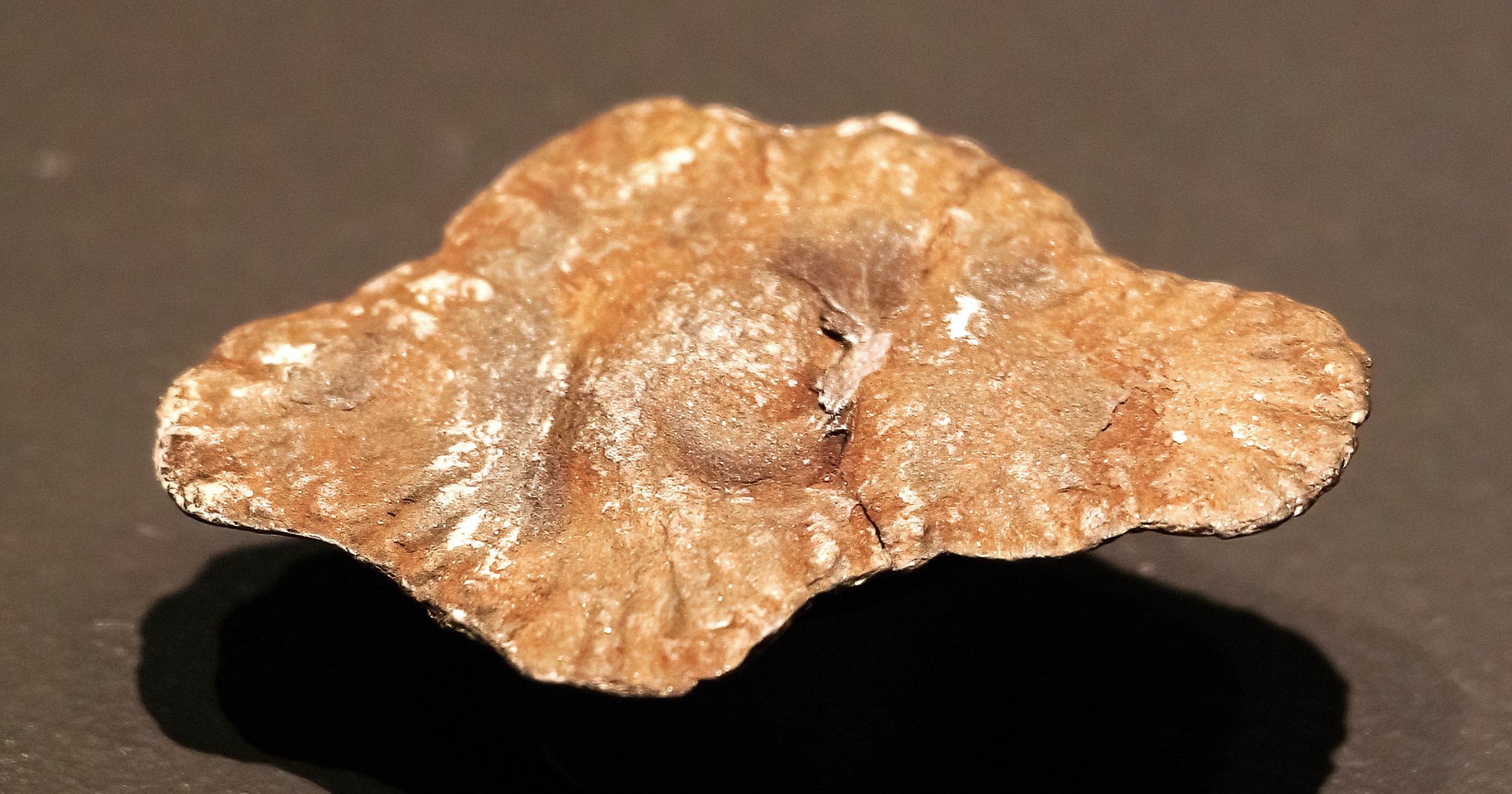 Evolution
Evolution
 Paleontology
Paleontology
Fossil Friday: How an Austrian Scientist Concocted a New Domain of Life called Gabonionta

In 2008 the Moroccan-French geologist Prof. Abderrazak El Albani from the University of Poitiers discovered strange three-dimensionally preserved radial structures in Proterozoic rocks of the Francevillian Formation in the West African country Gabon, which are believed to be about 2.1 billion years old. The ear-shaped structures of up to 6.7 inch size were interpreted as the earliest fossil evidence for multicellular eukaryotic life and were published two years later in the prestigious journal Nature (El Albani et al. 2010, Maxmen 2010).
In 2014, these findings were first presented to the general public with a special exhibition titled “Experiment Life – The Gabonionta” which opened in March 2014 at the Natural History Museum in Vienna (NHM 2014), and also featured a 40-minute documentary film by the University of Poitiers about the discovery. This exhibition was accompanied by a sensationalist media campaign in Austria, which included fancy headlines such as: “Gabonionta: sensational discovery in Vienna“ (ORF 2014), “Gabonionta, the little revolutionaries of evolution“ (Vosatka 2014), and “Gabonionta: How multicellular organism tried to conquer the Earth“ (Anonymous 2014).
Remarkable and Highly Unusual
It is remarkable and highly unusual in bioscience that the new taxon Gabonionta was never formally described as scientific name, but only used informally in public presentations and press releases. While El Albani refrained from formally naming the fossils, the new name Gabonionta was first introduced by the head of the paleontology department Dr. Matthias Harzhauser on occasion of the mentioned special exhibition at the Natural History Museum of Vienna. Therefore, it is commonly thought that this name Gabonionta, which designates an independent and extinct branch of multicellular life, is not taxonomically valid because it was not properly described according to the international rules of nomenclature. However, this is not true, because these rules do not apply to higher taxa above the family group level. Even if this name was only used in popular science publications, it is as scientifically valid and available as other higher taxonomic names such as Eukaryota or Metazoa.
More Important Issues
Anyway, there are more important issues with this discovery: other experts such as the famous German paleontologist Prof. Adolf Seilacher remained highly sceptical about the interpretation and suggested that the structures rather represent only pseudo-fossils formed by abiotic pyrite crystals during the diagenesis of the rocks. El Albani et al. (2014) responded to this critique and objected that not all of the fossils are pyritized and that the fossils formed at the same time as the sediment and therefore could not have been produced later by metamorphic processes. However, the initial critique was later strongly corroborated by the discovery of very similar structures from 1.1 billion year old sediments of Lake Michigan that were described by the authors as inorganic concretions (Anderson et al. 2016). Therefore, Javaux & Lepot (2018) remarked that “the identity of these macrostructures remains unknown and their biogenicity is questionable.” Even more recently, Fakhraee et al. (2023) came to a similar devastating conclusion. It looks like the dubious name Gabonionta does not even refer to any organism that ever existed. The scientists simply made up a new domain of life, based on nothing but inorganic patterns in ancient rocks.
Is there any other evidence that this sensational discovery was nothing but hype? Sure there is: after the 2014 media circus nobody ever published any primary research again about these “fossils” and the mysterious Gabonionta. Even in their newest paper about the Francevillian Biota, El Albani and his colleagues only described lenticular structures produced by agglutinated protists (Lekele Baghekema et al. 2017, Reynaud et al. 2017, El Albani et al. 2023), but no longer promoted the presence of multicellular organisms. The silence is deafening!
References
- Anderson RP, Tarhan LG, Cummings KE, Planavsky NJ, Bjørnerud M 2016. Macroscopic structures in the 1.1 Ga continental Copper Harbor Formation: Concretions of fossils? Palaios 31(7), 327–338. DOI: https://doi.org/10.2110/palo.2016.013
- Anonymous 2014. Gabonionta: Wie Mehrzeller versuchten, die Erde zu erobern. OÖNachrichten March 8, 2014. https://www.nachrichten.at/panorama/weltspiegel/Gabonionta-Wie-Mehrzeller-versuchten-die-Erde-zu-erobern;art17,1323424
- Lekele Baghekema SG, Lepot K, Riboulleau A, Fadel A, Trentesaux A & El Albani A 2017. Nanoscale analysis of preservation of ca. 2.1 Ga old Francevillian microfossils, Gabon. Precambrian Research 301, 1–18. DOI: https://doi.org/10.1016/j.precamres.2017.0
- El Albani A, Bengtson S, Canfield DE et al. 2010. Large colonial organisms with coordinated growth in oxygenated environments 2.1 Gyr ago. Nature 466, 100–104. DOI: https://doi.org/10.1038/nature09166
- El Albani A, Bengtson S, Canfield DE et al. 2014. The 2.1 Ga Old Francevillian Biota: Biogenicity, Taphonomy and Biodiversity. PLoS ONE 9(6):e99438, 1–18. DOI: https://doi.org/10.1371/journal.pone.0099438
- El Albani A, Konhauser KO, Somogyi A et al. 2023. A search for life in Palaeoproterozoic marine sediments using Zn isotopes and geochemistry. Earth and Planetary Science Letters 612:118169, 1–13. DOI: https://doi.org/10.1016/j.epsl.2023.118169
- Fakhraee M, Tarhan LG, Reinhard CT, Crowe SA, Lyons TW & Planavsky NJ 2023. Earth’s surface oxygenation and the rise of eukaryotic life: Relationships to the Lomagundi positive carbon isotope excursion revisited. Earth-Science Reviews 240:104398. DOI: https://doi.org/10.1016/j.earscirev.2023.104398
- Javaux EJ & Lepot K 2018. The Paleoproterozoic fossil record: Implications for the evolution of the biosphere during Earth’s middle-age. Earth-Science Reviews 176, 68–86. DOI: https://doi.org/10.1016/j.earscirev.2017.10.001
- Maxmen A 2010. Ancient macrofossils unearthed in West Africa. Nature News June 30, 2010. DOI: https://doi.org/10.1038/news.2010.323
- NHM 2014. Experiment Life – the Gabonionta. Press release March 7, 2014. https://www.nhm-wien.ac.at/presse/experiment_leben_-_die_gabonionta
- ORF 2014. “Gabonionta“: Sensationsfund in Wien. ORF.at March 11, 2014. https://wien.orf.at/v2/news/stories/2635417/
- Reynaud J-Y, Trentesaux A, El Albani A et al. 2017. Depositional setting of the 2·1 Ga Francevillian macrobiota (Gabon): Rapid mud settling in a shallow basin swept by high-density sand flows. Sedimentology 65(3), 670–701. DOI: https://doi.org/10.1111/sed.12398
- Vosatka M 2014. Gabonionta, die kleinen Revolutionäre der Evolution. DerStandard March 11, 2014. https://www.derstandard.at/story/1392687847479/gabonionta-die-kleinen-revolutionaere-der-evolution
